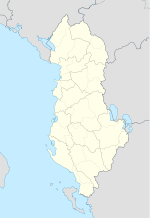Byllis
| Bylis (Albanian) Βύλλις or Βουλλίς (Greek) |
|

Detail of the late antique cathedral complex and the Adriatic sea in the distance.
|
|
| Location | Hekal, Fier County, Albania |
|---|---|
| Region | Illyria |
| Coordinates | 40°32′25″N 19°44′15″E / 40.5403°N 19.7375°ECoordinates: 40°32′25″N 19°44′15″E / 40.5403°N 19.7375°E |
| Type | Settlement |
| History | |
| Periods | Hellenistic, Roman, Byzantine |
| Cultures | Illyrian, Greek, Roman, Byzantine |
| Site notes | |
| Excavation dates | 1978–1991, 2000-present |
| Archaeologists | Camillo Prashniker, Neritan Çeka, Skënder Muçaj, Jean-Pierre Sodini, Pascale Chevalier, Nicolas Beaudry |
| Ownership | Public |
| Website | http://www.parkuarkeologjikbylis.gov.al |
Byllis (Ancient Greek: Βύλλις or Βουλλίς) was an ancient city located in the region of Illyria. The remains of Byllis are situated north-east of Vlorë, 25 kilometers from the sea in Hekal, Fier County, Albania.
Stephanus of Byzantium mentions Byllis as a seaside city (erroneously) in Illyria and its foundation legend, according to which the city was built by Myrmidons under Neoptolemus, returning from the Trojan War, a tradition confirmed by numismatics.
The Bylliones are first attested in the mid-4th century BC, in the description of the geographer Pseudo-Scylax, and also asking the oracle of Dodona to which god they should sacrifice in order to ensure the safety of their possessions. The archaeological attestation of the city is possible as far back as the second half of the 4th century BC and was later conquered by Pyrrhus. According to another view, Byllis was found by king Pyrrhus of Epirus.
Byllis received sacred Greek envoys, known as theoroi during the early 2nd century BC, indicator of the city's Greek character.
Byllis, being a Greek-speaking city, on the borders of Illyria and Epirus, had its own stadium and theatre during the Hellenistic era. About its foundation it has been suggested that Byllis was founded by Greek settlers, though the fact that it had a mixed population is attested by the Illyrian names of officials. The city had its own coinage which was different from that of the tribe of the Bylliones. M. B. Hatzopoulos believes that Byllis is the northernmost non-colonian Greek city in the region.
The walls of Byllis were 2,200m long, enclosing 30 hectares of a plain atop a hill 524m above sea level. There were 6 gates in the city walls. The road coming from Apollonia passed through two of them, crossing Byllis in the direction of the narrows of gorges of the Vjosa river on the way to Macedonia or those of Antigonia in the direction of Epirus. In 2011 during a road reconstruction near the archaeological park found in the site a statue of the Hellenistic era, which may depict an Illyrian soldier or a war deity, was discovered. However, there is little point in proposing an Illyrian label for city in which language, institutions, officials, onomastics, city-planning and fortifications were Greek.
...
Wikipedia

